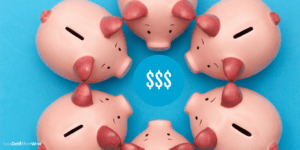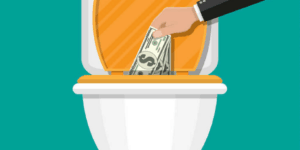How to Prioritize Your Debt so You Can Reach Debt Freedom
THIS POST MAY CONTAIN AFFILIATE LINKS. MEANING I RECEIVE COMMISSIONS FOR PURCHASES MADE THROUGH THOSE LINKS, AT NO COST TO YOU. PLEASE READ MY DISCLOSURE FOR MORE INFO.
The first step in any debt repayment plan is to decide what order you are going to pay off your debt. You need to prioritize because if you try to tackle too many things at once you won’t get anywhere with any of them.
There are two main methods used to prioritize your debt repayment. One focuses on emotional accomplishment and the other on long-term financial accomplishment. However, I also think there is a middle ground to help meld both emotional and financial achievement.
1. The Debt Snowball
The Debt Snowball is the emotional approach where you start with focusing on the smallest debt first. You make the minimum payment on all your debt but pay extra on the smallest debt. Once it is paid off you then roll what you were paying to the first debt into what you are paying on the second smallest debt.
Eventually, you end up with a large snowball of money that you are throwing (pun intended) at your debts until they have all paid off. This way focuses more on emotional accomplishment, because of the feeling of relief you get by quickly paying off a debt in its entirety, even if it is the smallest amount you owe.
2. The Debt Avalanche
The Debt Avalanche focuses more on long-term financial accomplishment as it is more financially sound. The debt avalanche has you paying off your debts in order of highest interest rate to lowest. As overtime you will pay less in interest, you will save more.
3. The Debt Nor’easter(?)
Ok so I’m still working on a snow-related name but it is a combination of the two. I was a math major in college, so I kind of consider logic to be one of my BFFs, accordingly the Debt Avalanche resonates with me more. However, I believe some debts have what I’ll call “emotional strings attached” that allow them to be bumped up the list regardless of their interest rates.
Why I Use the Debt Nor’Easter
For me, those would be (1)the bar loan my parents co-signed and (2)my car loan. The bar loan is something I want to pay off sooner rather than later because it is attaching my parent’s name to the bill.
Anytime your name is attached to someone else’s financially you have to rely on them to not hurt your financial landscape. Now my parents have a much better financial landscape than I do, so I would like to do everything to make sure I don’t drag them down in any way.
As for my car loan, I rely on my car for work. When I first got my car, I used it a lot to cover my three-state territory. I’m slightly afraid that the high amount of mileage will result in me needing another car at the same time I’m scheduled to have this one paid off.
For my own piece of mind, I’d like to have some time to save up for a car without making car payments. Given my interest rates and my debts with “emotional strings attached” I’ve bumped my car loan up the list.
How I’ve Prioritized My Debt
I have prioritized my debt payoff plan the following way to get the most savings and emotional relief:
- First Credit Card -21.99% (paid off)
- Second Credit Card -17.99% (paid off)
- Third Credit Card -14.99% (paid off)
- Bar Loan – 7% (refinanced in 2016 to 7% interest rate)
- Car loan-4.5% (66% paid off)
- Fed Loan Servicing loan #1-8.5%
- Sallie Mae loan #1-8%
- Fed Loan Servicing loan #2-7.9%
- Fed Loan Servicing loan #3-6.8%
- ACS Loan #1-6.5%
- Sallie Mae loan #2-6.3%
- ACS loan #2-5.34%
4. Bonus Debt Payoff Strategy – Snowflake Method
The snowflake method can be combined with any of the three debt repayment strategies mentioned above. The snowflake method, has you putting all extra money directly towards your debt throughout the month. It takes advantage of the fact that lots of small amounts can add up to make a big difference.
Got a rebate on something? It goes immediately to your debt. Found a dollar on the ground? It goes immediately to your debt.
Wrapping it up with a Bow on Top
No matter what debt repayment strategy you use or a combination of strategies, you can’t move forward in your debt repayment without having a plan, which means having a debt priority list. Pick one of the three talked about, here they are again for your convenience:
- Debt Snowball: Order debts smallest to largest. Payoff smallest amount first and work up to largest debt
- Debt Avalanche: Order your debts by interest rate, pay off the highest interest rate debt first.
- Debt Nor’Easter: Order by Snowball or Avalanche method and move any debts up the list based on their “emotional strings.”
Then decide if you are also going to add on the snowflake approach to help you destroy your debt even faster.
Any thoughts on my Debt Nor’easter plan or a better name for it? How do you plan to prioritize your debt?




I think debt – and finances in general – are emotional in nature. I recently wrote a blog post that showed through formulas how much money you would lose by paying off low-interest loans early. Almost all the commenters agreed with my assumptions and my model, but they admitted that paying off debt was emotional and they are willing to make an emotional decision to pay off debt even if they can see on paper that it might not be the best move.
Thanks for the comment! I think it definitely depends on what peace of mind is worth to you and the cost of peace of mind differs for everyone. For me, because of my student loans, both my bar loan and car loan would be paid off making the minimum payments before I even reached them on the list, but paying them off sooner, will save me the interest on those loans and give me a lot of peace of mind.